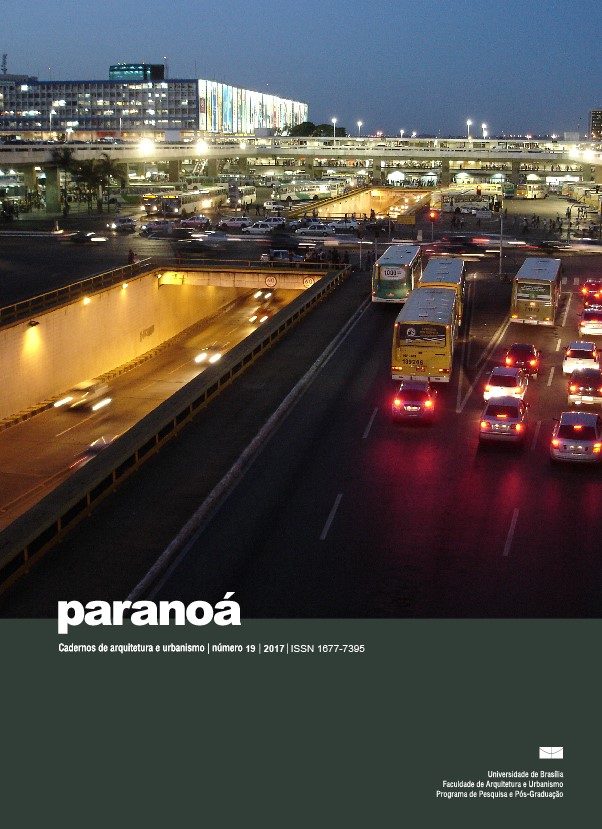Requisitos e critérios para projetos habitacionais: em busca de um desempenho ampliado
DOI:
https://doi.org/10.18830/issn.1679-0944.n19.2017.09Keywords:
Multifamily housing, Performance analysis, Multi-criteria decision analysis, Sustainability, Quality controlAbstract
Effective in Brazil since 2013, ABNT Standard 15575 brings guarantees to the quality of multifamily housing, as it establishes requirements and criteria related primarily to the physical properties of the building’s technological systems. However, the standard defines only minimum requirements and a performance of limited scope, which does not address crucial issues in a more comprehensive way ”“ such as importance of the interaction between the conception of the project and the choice of technological systems, the assessment of human responses or the contribution to various aspects of sustainability or to development. This paper seeks to highlight the need of coordinating architects, builders, suppliers and other agents such as institutions and regulatory agencies involved in the construction industry around this issue: the organization of this discussion will bring subsidies for a learning process concerning requirements/attributes to be prioritized in decision-making, allowing for a performance improvement in multifamily housing.
Downloads
References
CHEN, Y. et al. Sustainable performance criteria for construction method selection in concrete buildings. Automation in Construction. v. 19, n. 2, p. 235”“244, Mar. 2010.
CRONNBERG, T. et al, On structuring performance requirements for buildings. In: PERFOMANCE CONCEPT IN BUILDINGS SYMPOSIUM, 1. May 2-5, 1972, Philadelphia. Proceedings..., Philadelphia: RILEM/ ASTM/CIB, 1972b. p. 23 - 30. Vol. 1.
CRONNBERG, T. et al. Performance requirements for buildings. In: PERFOMANCE CONCEPT IN BUILDINGS SYMPOSIUM, 1. May 2-5, 1972a, Philadelphia. Proceedings..., Philadelphia: RILEM/ ASTM/CIB, 1972a. p. 13 a 22. Vol. 1.
FINGER, H. The role of the performance Concept in Operation Breakthrough. In: PERFOMANCE CONCEPT IN BUILDINGS SYMPOSIUM, 1. May 2-5, 1972, Philadelphia. Proceedings..., Philadelphia: RILEM/ ASTM/CIB, 1972. p. 819 - 839. Vol. 2.
FOSTER, B. (Ed.). Abstract. In: PERFOMANCE CONCEPT IN BUILDINGS SYMPOSIUM, 1. May 2-5, 1972, Philadelphia. Proceedings..., Philadelphia: RILEM/ ASTM/CIB, 1972. p. xvi. Vol. 2.
GROSS, J.G. 1996. Developments in the application of the performance concept in building. In: CIBA-ASTM-ISO-RILEM INTERNATIONAL SYMPOSIUM, 3, 1996, Tel Aviv. Proceedings..., Tel Aviv: Becker. R. and Paciuk, M. (Eds.), 1996. [s.p.] Vol. 1, I- 1. Disponível em: http://fire.nist.gov/bfrlpubs/build96/PDF/b96145.pdf. Acesso em: 10 Dez 2014
HYUN, C.T. Making value engineering as an effective tool for Project integration using constructability and partnering concepts. SAVE INTERNATIONAL CONFERENCE, 1, Proceedings…. 1997. p.111-118. Disponível em: http://www.value-eng.org/pdf_docs/conference_proceedings/1997/9716.PDF Acesso em: 22 Nov. 2015
LEMER, A. C.; MOAVENZADEH, F. Performance of systems of constructed facilities. In: PERFOMANCE CONCEPT IN BUILDINGS SYMPOSIUM, 1. May 2-5, 1972, Philadelphia. Proceedings..., Philadelphia: RILEM/ ASTM/CIB, 1972. p. 63 - 72. Vol. 1.
MANN, T., BENDER. Application of unobtrusive observation techniques in building performance, In: PERFOMANCE CONCEPT IN BUILDINGS SYMPOSIUM, 1. May 2-5, 1972, Philadelphia. Proceedings..., Philadelphia: RILEM/ ASTM/CIB, 1972. p. 93-100, Vol. 1.
MARTHUR, K.; McGEORGE, D. An integrated decision making environment for cost vs quality control. In: BEZELGA, A.; BRANDON, P.S. (Ed.) Management, Quality and Economics in Building. Taylor and Francis: London; 2006. p. 692 ”“ 701..
PASQUIRE, C. et al. What Should You Really Measure if You Want to Compare Prefabrication With Traditional Construction? In: ANNUAL CONFERENCE OF THE INTERNATIONAL GROUP FOR LEAN CONSTRUCTION, 13.2005. Sydney, Australia. Proceedings..., Sidney, 2005. p. 481-491
PENA, W. M.; FOCKE, J. W. Performance requirements of buildings and the whole problem. In: PERFOMANCE CONCEPT IN BUILDINGS SYMPOSIUM, 1. May 2-5, 1972, Philadelphia. Proceedings..., Philadelphia: RILEM/ ASTM/CIB, 1972. p. 43 - 56. Vol. 1.
PICANÇO, E. [199?]. Processo Decisório. Rio de Janeiro, Universidade Federal Fluminense. apostila, 72 p.
ROY, B. Multicriteria methodology for decisions Aiding. The Netherlands: Kluwer Academic Publishers, 1998.
SILVA, M. A. C. Metodologia de seleção tecnológica na produção de edificações com o emprego do conceito de custos ao longo da vida útil. 1996. 356 f. Tese (Doutorado em Engenharia Civil) - Escola Politécnica, Universidade de São Paulo, São Paulo.
STAATS, B. B. Operation Breakthrough: Lessons Learned about Demonstrating New Technology. Report to the Congress. Washington D.C. November 2, 1976. 87 p. Disponível em: http://www.gao.gov/assets/120/117465.pdf .Acesso em: 03 fev 2015
UGWU, O. O., HAUPT, T. C. Building and Environment. Key performance indicators and assessment methods for infrastructure sustainability - a South African construction industry perspective. Building and Environment. v.42. n.2, 2007. p.665”“680.
UNEP - United Nations Environment Programme. AGENDA 21. Integrating Environment and Development in Decision-Making. (Ch. 8) UNITED NATIONS CONFERENCE ON ENVIRONMENT AND DEVELOPMENT. Rio de Janeiro, Brazil, 3 to 14 June. 1992, Disponível em: http://www.unep.org/Documents.Multilingual/Default.asp?DocumentID=52&ArticleID=56 Acesso em: 12 set. 2015
UTOMO, C.; IDRUS, A. A Concept toward Negotiation Support for Value Management on Sustainable Construction. Journal of Sustainable Development. v. 4, n. 6, 2011. p 56- 66 - Disponível em: http://www.ccsenet.org/journal/index.php/jsd/article/view/8643; Acesso: 21 jan 2015.
VAN DER HEIJDEN, K.; Can internally generated futures accelerate organizational learning? Futures, Mar 2004, v. 36 n. 2, p.145-159.
YUNUS, R., YANG, J. An integrated approach to enhance sustainability in industrialized building systems. In: ASIA PACIFIC STRUCTURAL ENGINEERING & CONSTRUCTION CONFERENCE, 8. 2012, Surabaya. Proceedings… Surabaya: MD. NOOR, NORHAZILAN & ISMAIL, MOHAMMAD (Eds.), 2012. [s.p.] Disponível em: http://eprints.qut.edu.au/54731/ Acesso em: 07 Nov. 2014
Downloads
Published
How to Cite
Issue
Section
License
Autores que publicam nesta revista concordam com os seguintes termos:
- Autores mantém os direitos autorais e concedem à revista o direito de primeira publicação, com o trabalho simultaneamente licenciado sob a Licença Creative Commons Attribution que permite o compartilhamento do trabalho com reconhecimento da autoria e publicação inicial nesta revista. http://creativecommons.org/licenses/by/4.0
- Autores têm autorização para assumir contratos adicionais separadamente, para distribuição não-exclusiva da versão do trabalho publicada nesta revista (ex.: publicar em repositório institucional ou como capítulo de livro), com reconhecimento de autoria e publicação inicial nesta revista.
- Autores têm permissão e são estimulados a publicar e distribuir seu trabalho online (ex.: em repositórios institucionais ou na sua página pessoal) a qualquer ponto antes ou durante o processo editorial, já que isso pode gerar alterações produtivas, bem como aumentar o impacto e a citação do trabalho publicado (Veja O Efeito do Acesso Livre).















